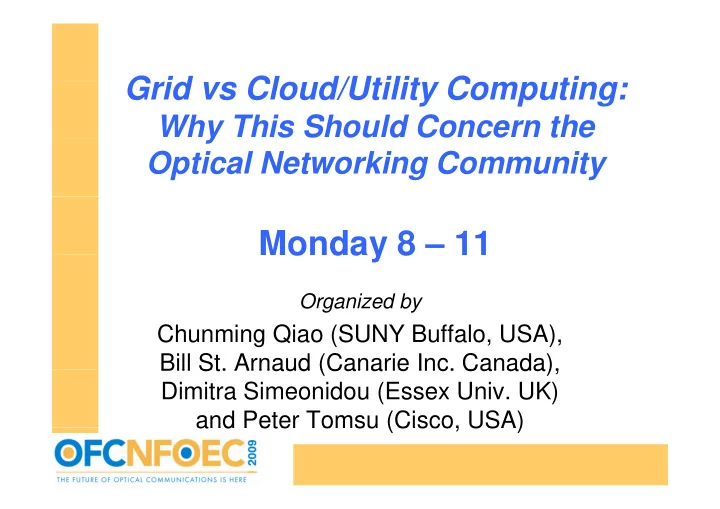

G id Grid vs Cloud/Utility Computing: Cl d/Utilit C ti Why This Should Concern the y Optical Networking Community Monday 8 Monday 8 – 11 11 Organized by g y Chunming Qiao (SUNY Buffalo, USA), Bill St. Arnaud (Canarie Inc. Canada), Bill St. Arnaud (Canarie Inc. Canada), Dimitra Simeonidou (Essex Univ. UK) and Peter Tomsu (Cisco, USA) and Peter Tomsu (Cisco, USA)
Speakers p Bill St Arnaud, Chief Research Officer,CANARIE Inc., Canada Canada Piero Castoldi, Scuola Superiore Sant'Anna Univ., Italy Cees de Laat, Univ. of Amsterdam, Netherlands Cees de Laat Univ of Amsterdam Netherlands Pascale Vicat-Blanc Primet, INRIA, France Rodney Tucker, U. Melbourne, Australia R d T k U M lb A t li Chunming Qiao, University at Buffalo (SUNY)
I t Introduction d ti What is Grid Computing? What is Cloud Computing? Grid Computing vs. Cloud G id C ti Cl d (Utility) Computing (Utility) Computing Grid/Cloud Computing over p g optical networks
B i f Hi t Brief History 1970s: Internet – TCP/IP protocols C / p otoco s 1980s: Cluster Computing – Beginning to exploit distributed resources Beginning to exploit distributed resources 1990s: Grid Computing – SETI@home uses spare CPU cycles worldwide SETI@h CPU l ld id 2000s: Cloud Computing – Google Apps, Amazon EC2
Th The Vision of Grid Computing Vi i f G id C ti Analogy to “Power Grid” – Computing power from a plug in the wall Computing power from “a plug in the wall” – Transparent exchange of computing power “ When the network is as fast as the “ Wh h k i f h computer’s internal links, the machine di i t disintegrates across the net into a set of t th t i t t f special purpose appliances ” (Gilder Technology Report, 2001)
Wh t i What is Grid Computing? G id C ti ? Grid Computing is the ability using a set of Grid Computing is the ability, using a set of open standards and protocols, to gain access to applications data CPU storage access to applications, data, CPU, storage, and other computing resources over the Internet Internet. A Grid is a distributed system that enables the sharing selection and aggregation of the sharing, selection, and aggregation of resources dispersed across multiple administrative domains based on their administrative domains based on their availability, capacity, performance, cost and users' QoS requirements users QoS requirements.
Wh t i What is Cloud Computing? Cl d C ti ? Cloud computing: Internet ("cloud") Cloud computing: Internet ( cloud ) based development and use of computer technology ( computing ). technology ("computing") Its style: dynamically scalable and often virtualized resources are provided as a virtualized resources are provided as a service over the Internet. – Users need not have knowledge of, Users need not have knowledge of expertise in, or control over the technology infrastructure "in the cloud" technology infrastructure in the cloud .
O Overview of Cloud Computing i f Cl d C ti Incorporates infrastructure as a service (IaaS) Incorporates infrastructure as a service (IaaS) , platform as a service (PaaS) , software as a service (SaaS) – e.g., Google Apps and Web service (SaaS) e.g., Google Apps , and Web 2.0 for satisfying the computing needs of the users users.
G id Grid vs. Cloud Computing Cl d C ti Cloud Computing is a natural next step Cl d C ti i t l t t from Grid Computing – Many Cloud Computing deployments today depend on Grids – Cloud Computing bills like utilities • The packaging of computing resources The packaging of computing resources (CPU, storage, software), as a metered service similar to a traditional public service similar to a traditional public utility such as electricity
Schedule Up to 20 min for Each Presentation – Clouds and Optical Networks, Bill St. Arnaud Clouds and Optical Networks, Bill St. Arnaud – Cloud Computing over Optical Networks, Piero Castoldi – Grid Computing over Optical Networks, Cees de Laat, Virtualizing and Scheduling Network Resource – inCARRIOCAS, Pascale Vicat-Blanc Primet i CARRIOCAS P l Vi t Bl P i t Energy/Cost Benefits of Cloud Computing, Rodney – T Tucker, U. Melbourne k U M lb – Concluding Remarks: Opportunities and Research Issues Issues , Chunming Qiao, Chunming Qiao There will be 35 min of Panel and Q&A session near the end of the workshop session near the end of the workshop
Recommend
More recommend